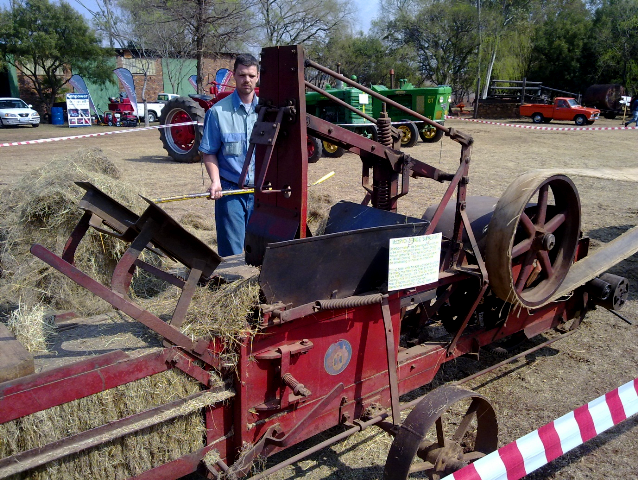It would actually be easier to write about our trip to the Agricultural Festival at the Willem Prinsloo Agricultural Museum in Afrikaans because few words are as satisfying as the word “plaasfees”. The Museum is about 40 kilometers out of Pretoria on the Cullinan road and showcases the history of the development of agriculture in South Africa from the Stone Age until 1945. It was a step back in time and an experience of farming as it used to be.
The first thing Gerhard did was to buy a bowl of “pap en kaiings”. I declined but I must say it was delicious and much less fatty than I thought it would be.
The museum consists of a farmyard, a house museum, a blacksmith shop and wagon shed. It is said that the house was already built when Willem Petrus Prinsloo, nicknames Willem Wragtag, bought the farm in 1889. The house brings lots of nostalgia with its riempiesbank and doilies and old, old photographs and of course, the coal stove in the kitchen.
The exhibitions included an old machine making hay bales. All you need is someone endlessly feeding the machine with hay. The machine compresses the hay into nice blocks and even runs a wire around it to keep it all together.
The machine runs on several linen bands linking all the moving parts. And of course, while we were watching, one of them broke. Thanks heavens for modern pistons.
There were several very old tractors. And most with billowing smoke as they ran.
There was plenty to do for kids with pony, camel and tractor rides and even rides on an old ossewa pulled by oxen.
Before we left we had a few obligatory cinnamon-sugar pancakes baked by a boeretannie in an apron. At the restaurant called Tant Miertjie se Kombuis they serve traditional meals like boontjiebredie and Tant Kotie se Winkel sure is the best place to buy a bottle of Mampoer or witblits.
But the thing I found most interesting was a version of a very old fridge. It is made of steel with birdwire around it. In the space between the wire and the cabin the farmers put coals. They then kept the coals wet and put the cabin in a draughty place outside. The top of the “fridge” also has space for water. Apparently, it worked like a charm. The boervrou could keep meat in there for quite a long time and even the butter was kept hard. No electricity required.



